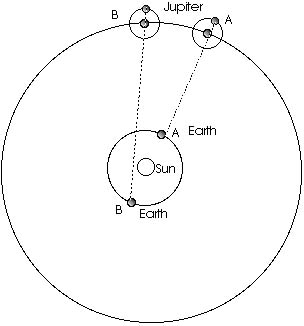|
|

|
|

c = 300,000 km/s = 3 x 108 m/s
This means that it takes light only about four minutes to travel the 140 million kilometers (or 93 million miles) from our Sun to Earth.
Galileo was the first to try to measure the speed of light. He employed a technique that had been used successfully to measure the speed of sound. Having stationed an assistant on a distant hill, he quickly lifted a cover from a lantern. His assistant quickly responded by lifting a cover from his lantern. Galileo then tried to measure the time that elapsed between his uncovering his lantern and his seeing the light from his assistant's lantern. He did this with several different assistants and over various distances. Galileo correctly concluded that the speed of light was so fast that he was really measuring the reaction time of his assistants rather than the speed of light.
Astronomical observations have been amazingly accurate for a very
long time. In 1675, the Danish astronomer Olaus Roemer found a
discrepancy of about twenty minutes in the time that Jupiter's
moons were eclipsed as they went behind Jupiter, depending upon
Earth's position in its orbit around our Sun. This difference
in time was due to the additional distance the light from Jupiter's
moons had to travel as shown in Figure 16.5. Roemer used this
information to calculate the speed of light. His calculated value
was low because, at that time, Earth's orbital radius was thought
to be smaller than it really is.

In 1727 the British astronomer James Bradley calculated the speed of light using careful measurements of the change in a star's position depending upon its location relative to the direction of Earth's orbital velocity. This change in position or change in angle is known as the angle of aberration of starlight and is similar to the change in direction of rain drops that we would measure from a moving convertible or a stationary convertible. Bradley's measured value was very close to today's value of 300,000 km/s.
In the nineteenth century the French Physicist Hippolyte Fizeau measured the speed of light using a toothed wheel and a distant mirror. When the wheel rotated at the right speed, it would be back in position to allow the reflected light to pass through the next opening in the wheel. The speed of light could then be determined by measuring the distance between wheel and mirror and by measuring the speed of the wheel.
A variation of this experiment was carefully refined by the American
Physicist Albert A Michelson who has rightfully been called the
"master of light". Michelson had been a midshipman at
the U S Naval Academy and then returned as an instructor. He carried
out research there by measuring the speed of light with great
precision. Today a line of round, brass markers show the location
of the light beam in Michelson's early experiments. Michelson's
apparatus is illustrated in Figure 16.6. Michelson later moved
to Case Institute of Technology in Cleveland OH where he and Edward
Williams Morley from the Western Reserve University did further
experiments involving light which will be quite important when
we study Relativity and Modern Physics.



Q: How much time does it take for light to travel one kilometer?
A: For this, we can go back to the ideas we developed about motion. The speed of anything is the distance it covers divided by the time, v = d/t. That means the time required is the distance divided by the speed, t = d/v. With d = 1 km and v = 300,000 km/s, this means
(need screen capture here)
Q: Why can we say that Galileo's early attempts to measure the speed of light really only measured the reaction time of his assistants (and himself)?
A: The speed of light is so great that the time required for light to travel any reasonable distance, such as a kilometer or even a few kilometers, is far less than human reaction time which is about a tenth of a second or so. Being so much less, this actual time of flight of the light is simply lost when compared to the much greater and variable reaction time.

|
|